Introduction
Alongside analyzing the data given by the Office of Institutional Research & Assessment, Team 2 gathered data through their own survey – What is it like to be at Hamilton College – that consisted of 22-23 questions. This survey was open from August 2nd to August 20th which was sent out to on-campus students, alumni, and faculty & staff to quantify and assess their experiences as Asian & Asian Americans. The roster of Asian & Asian Americans was collected through assistance from the: Levitt Research group, Asian Students’ Union, advising professors and various external/internal networks. Team 2 is aware and considerate of the limitations of having an incomplete roster in our analyses, so we highly prioritized the quality of our questions for potential future uses of the survey from not only the OIRA, but other cultural clubs and organizations as well.
This study utilized a survey design without participant manipulation. After indicating consent, participants were asked questions regarding whether they identify as a current student, alumni, faculty or staff member. From there point onwards, questions pertained to demographics, their Asian identity, the COVID-19 pandemic, and experiences before, during & after their time at Hamilton College. The survey was completely anonymous.
Survey Structure
1) Demographics
The demographic section asked for participants to indicate their status at Hamilton College (i.e. current student, alumni, faculty or staff member), birth country, gender identity, and Asian identity (i.e. Asian including international students or multi-racial). The sample for this survey consisted of 130 Hamilton community members: 81 students (74 female, 39 male, 2 non binary, 1 prefer not to say), 26 alumni, and 7 faculty and 2 staff members.
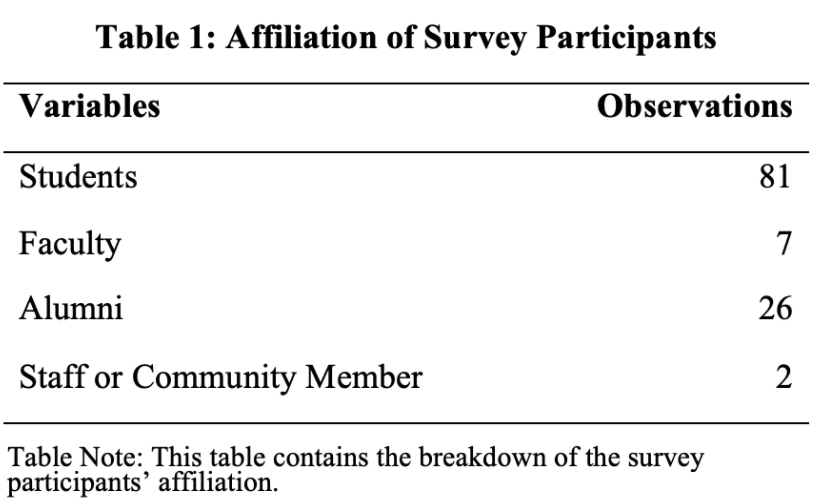

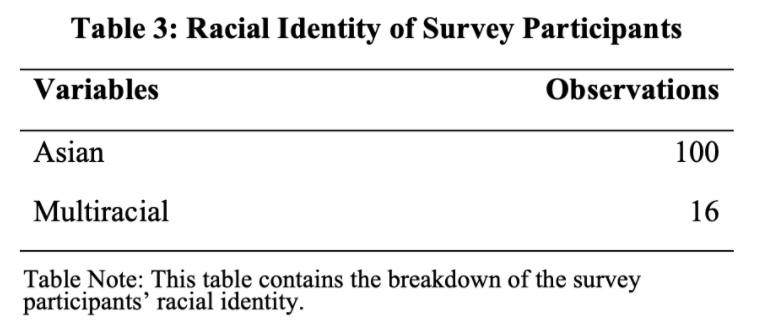
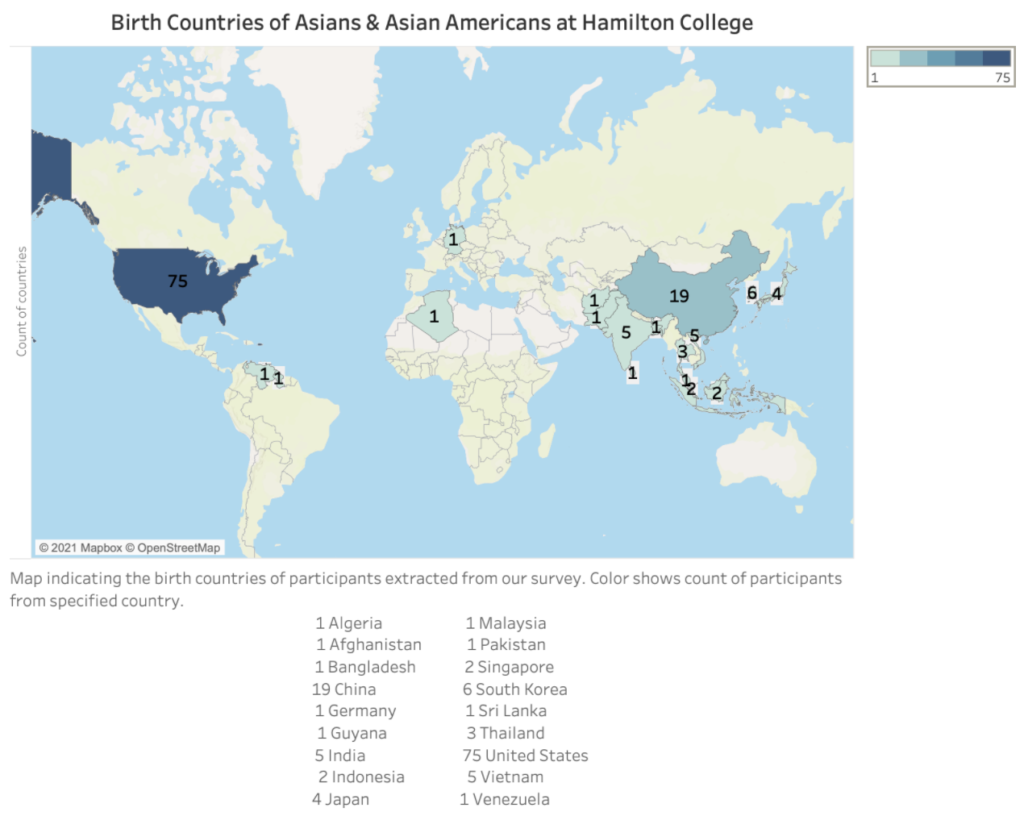
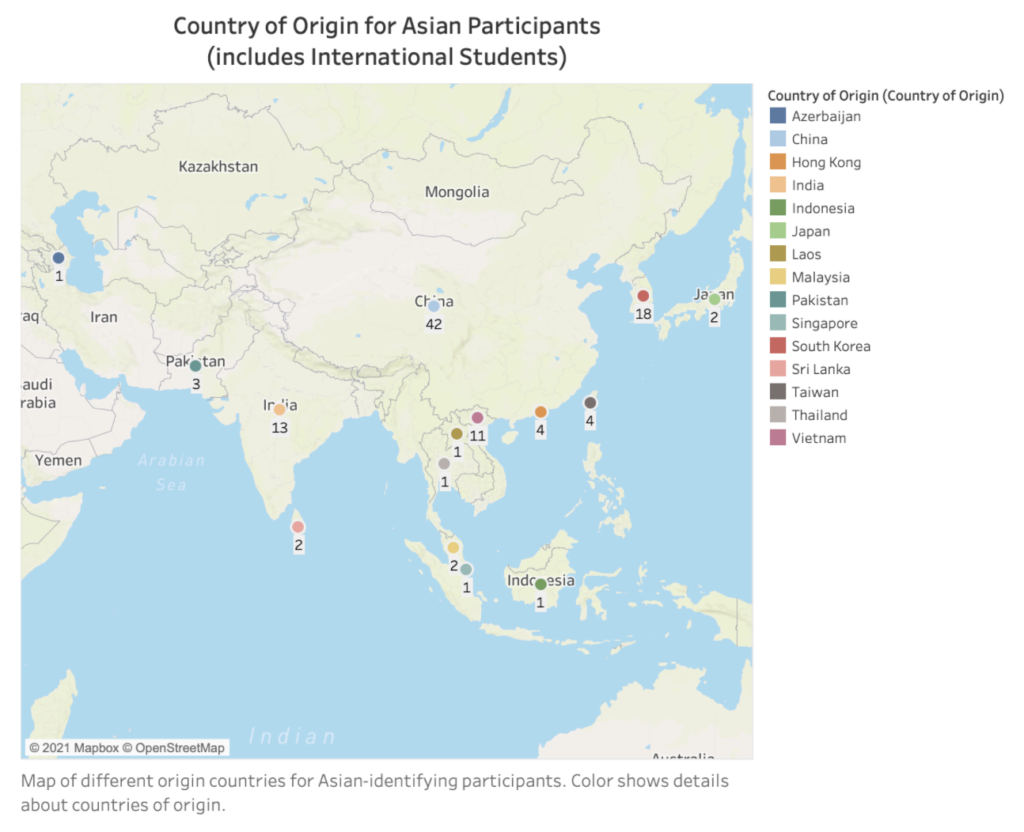
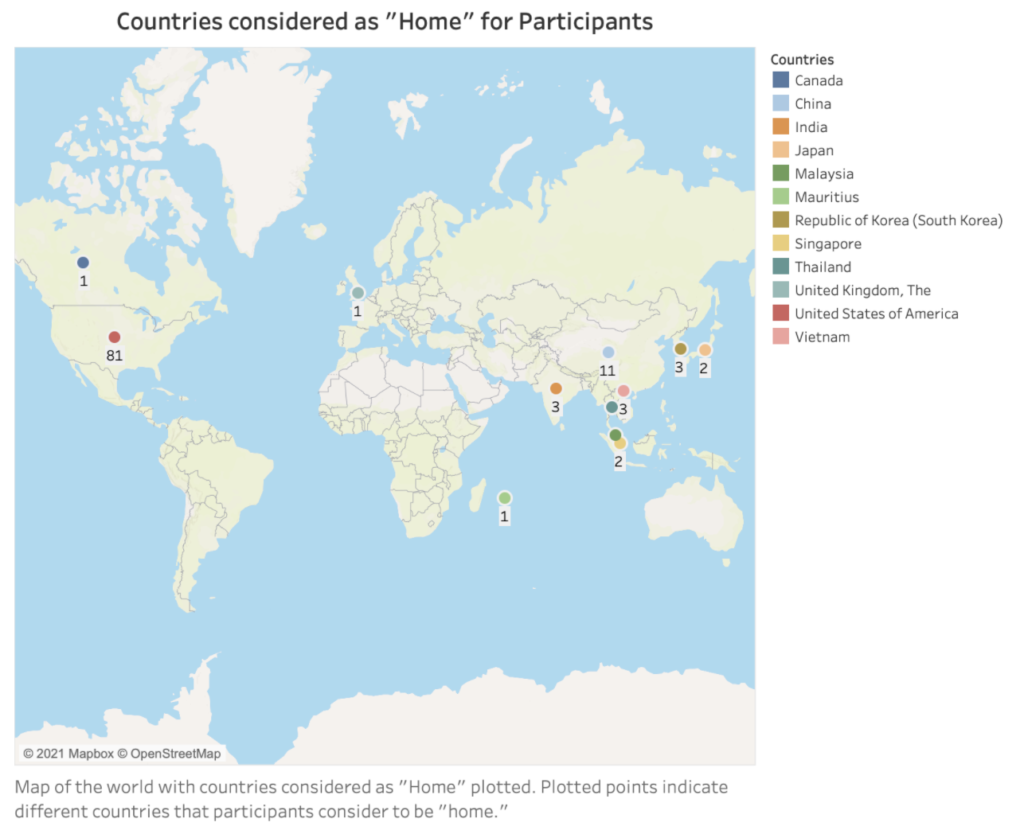
2) Before Hamilton
All participants were asked questions about their upbringing and experiences before Hamilton. Using respective 7-point Likert scales, participants responded to questions such as, “How much do you feel like moving impacted the person you are today?” (1 = absolutely no impact; 7 = absolutely impacted), “Growing up, did you feel like you were part of the minority or majority?” (1 = strongly minority; 7 = strongly majority), and “Did you feel that mental health was encouraged throughout your upbringing?” (1 = strongly discouraged; 7 = strongly encouraged). Participants also answered two statements about their mental health using a 7-point Likert scale (1 = strongly disagree; 7 = strongly agree).
3) At Hamilton
All participants were asked questions about their time at Hamilton college. The survey used respective 7-point Likert scales for questions such as, “Did you feel comfortable talking about racial issues?” (1 = Extremely uncomfortable, 7 = Extremely comfortable). In addition to the 7-point scales questions, we had slider scales (0-100) for questions asking about what the number of Asian/POC/Caucasian close friends people had.
4) After Hamilton
Alumni were the only sample group to answer questions pertaining to their experiences after attending Hamilton College. Alumni read the following statement and answered using a 7-point Likert scale (1 = strongly disagree; 7 = strongly agree): “Your racial identity affects your role in the workplace.”
SUMMARY
The Impact of Covid on-campus atmosphere towards Asian & Asian Americans
It’s been more than a year since Covid-19 was officially declared a national emergency in the United States, and the pandemic continues to impact the Asian American community. It has had an unequal impact on the businesses and livelihoods that make up the Asian American community. We have also witnessed a spike in anti-Asian violence. Furthermore, Asian American unemployment increased from the lowest rate in the country at 2.8 percent in August 2019 to one of the highest at 10.7 percent in August 2020. Asian Americans comprise 6 percent of the US population, but Asian American-owned businesses make up 26 percent of food and accommodation, 17 percent of retail trade, 13 percent of healthcare and social services, and 11 percent of education services. There are more than 9,081 incidents documented by the nonprofit Stop AAPI Hate in the US since the pandemic started (The Guardian, 2021). The Asian American community continues to face lasting effects from the Covid-19 pandemic.
In response to the alarming escalation in xenophobia and bigotry resulting from political rhetoric about the COVID-19 pandemic, multiple organizations including the Asian Pacific Policy and Planning Council (A3PCON) and Chinese for Affirmative Action (CAA) launched the Stop AAPI Hate coalition on March 19, 2020. Stop AAPI Hate aims to track and respond to incidents of hate, violence, harassment, discrimination, shunning, and child bullying against Asian Americans and Pacific Islanders in the United States (Stop AAPI Hate, 2021). It was enlightening for the majority of Asians and Asian Americans to witness our community come together and support one another during this difficult time. Coming from a history where minorities have been pitted against one other, it was empowering to see multiple protests organized across the nation to fight for justice. However, as the Asian and Asian American community at Hamilton returned to campus, we felt that the campus atmosphere wasn’t as supportive. Especially when the Atlanta spa shooting occurred, we felt that there wasn’t any support or safe spaces coming from the college. Campus was deathly quiet, and Asian and Asian American students were distraught. Like many times in Asian American history, this incident was swept under the rug.
Based on our survey, Asians and Asian Americans in the Hamilton community believe that there was a drastic change in attitude towards the Asian and Asian American community throughout the nation. Even though figure 7 depicts that participants were either unsure or hesitant to say that there was a “negative change” on campus after the pandemic, figure 8 illustrates its impact off campus. Although the question did not state whether the change of racial perceptions towards Asians was negative or positive, the participants all agree that there was a shift of attitude from the general public towards Asians and Asian Americans.
Hamilton’s value statement states that “At Hamilton, we embrace diversity, commit to work against systemic racism and bigotry, and support a community where all individuals, without exception, feel valued, empowered, and treated fairly (Diversity, Equity & Inclusion; https://www.hamilton.edu/about/diversity)”. In light of the Atlanta spa shooting and the hate crimes the Asian community has faced throughout the pandemic, the college has neglected the Asian community at Hamilton. We require more support and action from the college especially in times of need.
Lack of resources that are accustomed / tailored towards the inclusivity of Asian & Asian Americans
The bar graph in Figure 6 demonstrates that Asian & Asian American students at Hamilton College mainly feel indifferent toward the existing support / resources on campus. For the statements “Hamilton does enough to support Asian & Asian Americans” and “My voice is represented on campus” we deduce that the peak for “Neither agree nor disagree” answer shows the lack of knowledge and opinion on these resources and support. This weak opinion on resources and support from Hamilton College is directly correlated to the lack of inclusivity of Asian & Asian Americans because it is very rare for people to stay indifferent about the support they get if those resources were well communicated and they feel truly included. For example, ASU not being part of the DMC because of a lack of “club infrastructure” and “leadership and willing members to join the DMC” creates the impression that our college is hesitant to give Asian & Asian American students the administrative support that are needed in our efforts to feel represented and the sustainability of our cultural presence is not important to institutions such as the DMC. The Peer Mentoring Program (MP2) is the only existing network support geared towards first generation, POC, and international students that Hamilton College offers. The program receives much positive feedback and it is a valued part of our Hamilton College experience. As the year progresses, we have an influx of peer mentees and high demand for peer mentors, which demonstrates that programs such as MP2 that foster a culturally considerate dynamic between mentees and mentors are much needed in our community. More efforts in building such programs would be very much appreciated.
Inclusivity requires clear and consistent communication to inform community members about available resources and support. For this reason, we cannot stay satisfied with the “neutral” answer for this statement, but demand more effort and support towards the Asian & Asian Americans on campus to create an inclusive community.
Limitations
Regarding our methods to carry out this survey, we encountered several limitations. As mentioned in the beginning, our first limitation stems from the incomplete roster we obtained for this survey. For the distribution of our survey we utilized a roster of Asian & Asian Americans collected through assistance from our Levitt Research group, Asian Students’ Union, advising professors and various external/internal networks. A reason for our pursuit in constructing a more inclusive and sustainable survey was due to the fact that Hamilton’s databases separated Asians from international students as well as multiracial students; however, this in turn led to an incomplete roster, altering how many participants we acquired. Additionally, as with 7-point Likert scale surveys, every individual has different interpretations of each question and response options. For example, the “I feel like I belong” question may carry various types of understanding of the concept “belonging”. This is to demonstrate that each participant approaches each question differently based on their background and prior experience. Due to the uni-dimensional characteristics, Likert scales may fail to measure the true attitudes of participants at any given time.
General feelings
After analyzing and reflecting on our survey findings, we felt the overall results spoke to the diverse experiences among Asian-identifying individuals at Hamilton College, while also affirming some commonalities found in Asian cultures. Firstly, the statement, “At Hamilton, I feel like I belong”, received a wide range of responses that, when represented as a histogram, skewed left with more responses agreeing with the question. This statement in particular was difficult to interpret due to the multitude of definitions for “belonging.” One participant may define and comprehend “belonging” in a completely different manner than the next.
Majority of participants responded with, “Neither agree nor disagree” to questions such as, “Hamilton does enough to support Asians and Asian Americans”, “My voice is represented on campus”, and “There was a negative change in the campus atmosphere towards Asians after the pandemic.” While responding with neutral answers may be usual with the use of Likert scale surveys, these findings may speak more to the relationship with compliance and Asian cultures. Researchers Wang et al. (2008) studied why Asians avoid responding with extreme answers and found that Asian/Asian American students consistently reported the middle option more often than other racial groups. Venturing from a collectivist to an individualistic society such as the United States, voices of Asian immigrants may be drowned out in their attempt to obey and comply with authority. The histograms for, “On campus, I have been on the receiving end of racial discrimination”, and “Within the community surrounding Hamilton, I have been on the receiving end of racial discrimination,” both show peaks for the neutral options with 22 and 26 responses, respectively. With our sample consisting of only Asian and Asian American people, the uniformity in cultural backgrounds may play a role in why many of the responses for this survey were neutral and/or avoiding extreme options.
Team 2’s mission is to amplify Asian voices. To do so, we intend to share this survey data with the Hamilton community. We want to draw attention to the needs of the Asian and Asian American, Pacific Islander, and Desi American community at Hamilton. We hope for more support and action from the college to ensure a safe, inclusive, and supportive environment for Asians and AAPIDAs on campus.
This survey was intended to better measure the level of satisfaction currently and develop a sustainable model for future data collection in order to quantify improvements. We hope for the college’s Office of Institutional Research & Assessment to continue to build upon and improve our survey and implement it in the future. Asian voices deserve to be heard and observations from student surveys allow us to deduce key issues to address within the campus community. Analyzing these quantitative patterns helps us understand the bigger picture of Asian/Asian American experiences.
Alongside this survey, Team 2 took to social media and formed an Instagram account called “The Asian Medium” as an additional platform for sharing our research and findings. With this account, we hope to provide our community with a long-lasting space to feel heard and seen. Along with our summer research, the account features content on Asian and Asian American history, culture, and current events. It is growing and still a work in progress, but we hope to continue to expand our platform and reach communities beyond Hamilton. We will continue to amplify Asian voices and make our voices heard.
Bibliography
Matthew K. Chin, Lan N. Đoàn, Stella K. Chong, Jennifer A. Wong, Simona C. Kwon “Asian
American Subgroups and The Covid-19 Experience: What We Know and Still Don’t
Know.” Health Affairs, May 24, 2021.
https://www.healthaffairs.org/do/10.1377/hblog20210519.651079/full/.
Stop AAPI Hate, June 17, 2021. https://stopaapihate.org/.
Chung, Michelle. “Multicultural Peer Mentoring Provides Support.” Hamilton College, October
22, 2019. https://www.hamilton.edu/news/story/multicultural-peer-mentoring-support.
Wang, Rui, Brian Hempton, John P Dugan, and Susan R Komives. “Cultural Differences: Why
Do Asians Avoid Extreme Responses?: Published in Survey Practice.” Survey Practice,
October 1, 2008.
https://www.surveypractice.org/article/2913-cultural-differences-why-do-asians-avoid-ext
reme-responses.
Yang, M. (2021, August 12). More than 9,000 Anti-asian incidents reported in US Since
pandemic started. The Guardian. Retrieved September 16, 2021, from
https://www.theguardian.com/world/2021/aug/12/anti-asian-stop-aapi-hate-covid-report.
